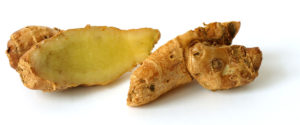Galanga is a generic term for 4 plants in the ginger family, originally from Indonesia.
The plants have several things in common, but the most characteristic is that they are used in both gastronomy and natural medicine and that it is always the root parts (rhizomes) that are used.
As mentioned, galangal plants are related to ginger and therefore resemble ginger in many ways. However, galangal root does not taste like ginger and the difference in taste is most noticeable in raw galangal root.
In natural medicine, galangal root is mainly used for gastrointestinal problems such as dyspepsia, nausea, flatulence and loss of appetite.

There are 4 different species of galanga and their roots can all go under the name ‘galangarod'
Historical uses of galangarod
Europe
Galangarod was a widespread and popular natural remedy in medieval Europe as well as in the time leading up to this period. Described as “a root with the scent of roses and the taste of spices”, it was used as a spice and aphrodisiac. In practice, dried galangaroo root was worn to enhance virility, but also to protect against evil. Since the Middle Ages, the use of galangal root in Europe has been in steep decline. However, the growing interest in natural medicine and exotic cooking in recent years has slightly increased the demand for the root.
The only exception to this trend is Eastern European countries, where it has long been popular. Examples include Lithuania and Estonia, where it is used as a spice and medicine, and Poland, where it is used as a flavoring in vodka.
Asia
Although galangal originated in Indonesia, they have long been widespread throughout much of Asia. Examples include the gastronomic use of galangal roots in China, Thailand, Vietnam, Cambodia, Indonesia, Java, Bali and India. However, there are differences in how much each galanga root is used in each country – for example, ‘Kaempferia galanga' is mostly used in countries such as China, Java and Bali, while it is hardly used in Thailand.
Galangarod is also available in powdered form and can be used in the Indian spice blend ‘curry'. In India, extracts of galangarod are also used in things as diverse as perfume, tea and tartare, as well as for bad breath. In several Asian countries, the galangarod Alpinia officinarum is also used in drinks and jams.
In some Asian cultures, galangal roots are also used for their magical properties. Although this use is ancient, it is still widespread today.
Natural medicine uses
In natural medicine, galangal root is used for many of the same purposes as ginger. Some of the uses of galangarod include:
- Gastrointestinal system: Galangarod is said to have a stimulating effect on digestion and could therefore be used for dyspepsia (indigestion), upset stomach, nausea, flatulence (gas) and decreased appetite. Some herbalists recommend the following mixture for women who have just given birth; old chopped and ground galangal root, mixed with tamarind, water and salt. The mixture is said to purify the blood and help remove accumulated air in the intestinal tract, and its mild laxative effect should also help to keep stools regular. The natural remedy ‘Bitterstern' is made to counteract several of these gastrointestinal problems and contains galangal root.
- Heat: The natural warmth of galangarod root is said to be useful for cramps, numbness, bruising, swelling and respiratory disorders. In addition, it is also said to be effective against skin diseases as it supposedly removes toxins from the body.
- Colds and sore throats: The galanga root Alpinia galanga is used in Tamil natural medicine for colds and sore throats. The root is also used in Ayurvedic herbal medicine for similar purposes.
Medicinal uses and potential
Alpinia officinarum
The galanga root Alpinia officinarum contains high concentrations of the flavonoid galangin, which has been shown to reduce the growth of breast cancer cells.
Kaempferia galanga
The galangal root Kaempferia galanga has been shown to be effective against roundworms in dogs (Toxocara canis) and certain other protozoa. In 1999, it was discovered that the root inhibits the Epstein-Barr virus, which causes the disease mononucleosis.
The root can also be used to control larvae of the mosquito species Culex quinquefasciatus and to deter the mosquito species Aedes aegypti, which spreads diseases such as dengue fever, chikungunya, yellow fever and others. This is why the root's potential as an insecticide is being researched today.
Galanga and galanga root
‘Galanga' is a term for the following four species in the ginger family (Zingiberaceae):
- Alpinia galanga
- Alpinia officinarum
- Kaempferia galanga
- Boesenbergia rotunda
As can be seen from the Latin names, all species do not belong to the same genus (Alpinia, Kaempferia and Boesenbergia), but are still grouped together under the name ‘galanga' because of their common features. One of the species' most distinctive commonalities is their rhizomes, which are used gastronomically and medicinally and are called ‘galangarod'.
When talking about ‘galanga root' in European languages, the species Alpinia galangal and Alpinia officinarum and to some extent also Kaempferia galanga are usually referred to – but the word ‘galanga root' can in principle be used for all four species mentioned above. Sometimes the somewhat loose term ‘Thai ginger' is also used for the species Alpinia galangal and Alpinia officinarum.
